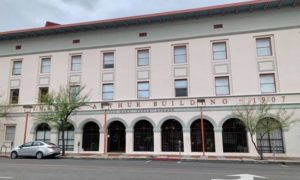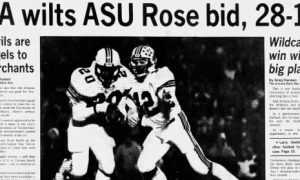FOLLOW @JAVIERJMORALES ON TWITTER!
[rps-paypal]
[ezcol_1half id=”” class=”” style=””]

— General history
— J.F. “Pop” McKale
— The games
— Comparisons then and now
— Wildcats nickname
— Military service
— Rankings
[/ezcol_1half]
[ezcol_1half_end id=”” class=”” style=””]
Excerpt from L.A. Times, Nov. 8, 1914, authored by Bill Henry:
“Arizona’s cactus-fed athletes, despite heroic efforts on the part of their two halfbacks, (Asa) Porter and (Franklin) Luis, went down to defeat before the Occidental Tigers yesterday afternoon, the tally with all precincts heard from being 14 to 0 in favor of the Tigers.
Confident of rolling up a big score, the Tigers took the field with grins on their faces, but before the game was 10 seconds old they knew they had a battle on their hands.
The Arizona men showed the fight of wild cats and displayed before the public gaze a couple of little shrimps in the backfield who defied all attempts of the Tigers to stop them.”This site will conduct a countdown in a 100-day period, leading up to Arizona’s 2014 football season-opener with UNLV on Aug. 29 at Arizona Stadium. The 100 Days ‘Til Kickoff countdown will include information daily about the historic 1914 Arizona team that helped create the school’s nickname of “Wildcats” because of how they played that fateful day against Occidental.
[/ezcol_1half_end]
[ezcol_1half id=”” class=”” style=””]
Arizona Stadium was not constructed until 1928, so where did J.F. “Pop” McKale and his team play in 1914?
The “Varsity” played on a field located in an area where the old administration building and chemistry building were later situated. It was a dirt field on the south side of the present Arizona mall, to the southeast of Old Main.
According to the book They Fought Like Wildcats, written by Abe Chanin in 1979, Tucsonan watched games from different vantage points in 1914.
“There was no grandstand, so they sat on the ground, they perched on the seats of their buggies, or in their high-topped motor vehicles,” Chanin writes. “And there were some fans who sat high in the saddles of their horses.”
[/ezcol_1half]
[ezcol_1half_end id=”” class=”” style=””]
[/ezcol_1half_end]

An aerial view of Arizona’s campus circa 1914 (University of Arizona Library Special Collections)
Orville “Speedy” McPherson, a fullback on the 1914 team, was instrumental in the development of Arizona Stadium (called the West Stadium then) in 1928. McPherson and Kirke Tonner Moore (letterman from 1900-03) appeared before the Board of Athletics Control (composed of full-time graduate managers and representatives of the student body and faculty) in 1921 to pitch the idea for the stadium.
The Arizona Board of Regents purchased two blocks of land for the stadium at Sixth Street between Vine Street on the west and Cherry Street on the east.
The Board of Regents stipulated that the alumni must raise $100,000 toward the stadium’s cost. The school’s president Homer LeRoy Shantz used the theme, “We must pull together” to gain support. McKale, as athletic director and football coach, was very active in this campaign.

The 1914 Arizona football team that earned the honor of being named the first “Wildcats” was composed of (front row, left to right): Verne La Tourette, George Seeley, Leo Cloud, Richard Meyer, Asa Porter. Second row: Franklin Luis, Lawrence Jackson, Ray Miller, J.F. “Pop” McKale (coach), Turner Smith, Harry Hobson (manager), Orville McPherson, Albert Crawford, Ernest Renaud. Back row: Albert Condron, Emzy Lynch, Charley Beach, Vinton Hammels, Bill Hendry, George Clawson, Harry Turvey.
(AllSportsTucson.com graphic/Photo from University of Arizona Library Special Collections)
[ezcol_1half id=”” class=”” style=””]
On This Date in 1914
Wed., June 14, 2014
The first section of the proposed Santa Fe Highway at the northern part of the state is completed. Newspaper reports indicate that the travel time from Kingman to Los Angeles would be “only 11 hours” when finished. Flagstaff was a significant summer colony for people heading west from California.
[/ezcol_1half]
[ezcol_1half_end id=”” class=”” style=””]
[/ezcol_1half_end]
Alumni, faculty and students pulled together $25,000 toward the $100,000 goal. The copper companies in Arizona helped the school reach its goal with their donations.
In the 1929 christening of Arizona Stadium, the Wildcats defeated Cal Tech 35-0 in the homecoming game. The Wildcats went 7-1 overall under McKale that season, including a perfect 4-0 at the new stadium. They shut out the four opponents by a combined score of 129-0.
ALLSPORTSTUCSON.com publisher, writer and editor Javier Morales is a former Arizona Press Club award winner. He also writes articles for Bleacher Report and Lindy’s College Sports.




























